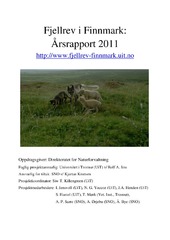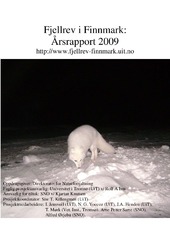Blar i forfatter "Mørk, Torill"
-
Case report: Subclinical verminous pneumonia and high ambient temperatures had severe impact on the anesthesia of semi-domesticated Eurasian tundra reindeer (Rangifer tarandus tarandus) with medetomidine-ketamine
Tryland, Morten; Josefsen, Terje D.; Sanchez Romano, Javier; Marcin, Nina; Mørk, Torill; Arnemo, Jon Martin (Journal article; Tidsskriftartikkel; Peer reviewed, 2021-02-24)Semidomesticated Eurasian tundra reindeer (<i>Rangifer tarandus tarandus, n</i> = 21) were scheduled twice for chemical immobilization with medetomidine–ketamine as part of a scientific experiment in June 2014. During the first round of immobilizations, seven animals developed severe respiratory depression (RD). Three individuals died, and 4 recovered. The ambient temperature during the 2 days of ... -
Cervid herpesvirus 2 and not Moraxella bovoculi caused keratoconjunctivitis in experimentally inoculated semi-domesticated Eurasian tundra reindeer
Tryland, Morten; Sanchez Romano, Javier; Marcin, Nina; Nymo, Ingebjørg Helena; Josefsen, Terje Domaas; Sørensen, Karen Kristine; Mørk, Torill (Journal article; Tidsskriftartikkel; Peer reviewed, 2017-04-24)Background: Infectious keratoconjunctivitis (IKC) is a transmissible disease in semi-domesticated Eurasian reindeer (Rangifer tarandus tarandus). It is regarded as multifactorial and a single causative pathogen has not yet been identified. From clinical outbreaks we have previously identified Cervid herpesvirus 2 (CvHV2) and Moraxella bovoculi as candidates for experimental investigations. Eighteen ... -
Fatal inanition in reindeer (Rangifer tarandus tarandus) : pathological findings in completely emaciated carcasses
Sørensen, Karen K.; Josefsen, Terje D.; Mørk, Torill; Mathiesen, Svein D.; Ryeng, Kathrine A. (Journal article; Tidsskriftartikkel; Peer reviewed, 2007-09-28)Background: In a project to determine the causes of winter mortality in reindeer in Finnmark County, northern Norway, the most frequent diagnosis turned out to be complete emaciation, despite several of the reindeer having been given silage for up to 4 weeks before they died. The present paper describes autopsy results and other findings in these animals. Methods: Autopsies were made of 32 ... -
Fjellrev i Finnmark : årsrapport 2011
Killengreen, Siw Turid; Jensvoll, Ingrid; Henden, John-André; Hamel, Sandra; Ims, Rolf Anker; Mørk, Torill; Sarre, Arne Petter; Ørjebu, Alfred; Bye, Åshild; Knutsen, Kjartan (Research report; Forskningsrapport, 2012) -
Fjellrev i Finnmark : Årsrapport 2013
Ims, Rolf Anker; Killengreen, Siw Turid; Jensvoll, Ingrid; Yoccoz, Nigel Gilles; Henden, John-André; Arriola, Aline; Mørk, Torill; Sarre, Arne Petter; Ørjebu, Alfred; Kristoffersen, Bjørn Hugo; Bye, Åshild (Research report; Forskningsrapport, 2013)Prosjekt Fjellrev i Finnmark har pågått siden 2004. Prosjektet har fra starten av hatt to målsetninger: Å gjøre grunnleggende forskning på økosystembetingelser som begrenser fjellrevenbestandens nåværende utbredelse og bestandsvekst i Øst-Finnmark spesielt, og i sub- og lav-Arktis generelt, med fokus på to hypoteser; a) mer uregelmessige og dempede smågnagersykler og b) øket konkurranse med ... -
Fjellrev i Finnmark: Årsrapport 2009
Ims, Rolf Anker; Mørk, Torill; Sarre, Arne Petter; Killengreen, Siw Turid; Knutsen, Kjartan; Jensvoll, Ingrid; Yoccoz, Nigel Gilles; Ørjebu, Alfred; Henden, John-André (Research report; Forskningsrapport, 2009) -
Fôring av reinsdyr – og fôringsrelaterte sykdommer
Eilertsen, Svein Morten; Winje, Erlend; Davidson, Rebecca K.; Mørk, Torill; Nymo, Ingebjørg Helena (Research report; Forskningsrapport, 2022) -
Infectious Disease Outbreak Associated with Supplementary Feeding of Semi-Domesticated Reindeer
Tryland, Morten; Nymo, Ingebjørg Helena; Sanchez Romano, Javier; Mørk, Torill; Klein, Joern; Rockström, Ulrika (Journal article; Tidsskriftartikkel; Peer reviewed, 2019-04-18)Supplementary winter feeding of semi-domesticated reindeer (<i>Rangifer tarandus tarandus</i>) has become more common in Sweden and Norway due to reindeer pasture fragmentation and climatic conditions. With increased corralling and feeding, often associated with animal stress, increased animal-to-animal contact, and poor hygienic conditions, an altered range of health challenges and diseases may ... -
Infectious keratoconjunctivitis in semi-domesticated Eurasian tundra reindeer (Rangifer tarandus tarandus): Microbiological study of clinically affected and unaffected animals with special reference to cervid herpesvirus 2
Sanchez Romano, Javier; Mørk, Torill; Laaksonen, Sauli; Ågren, Erik; Nymo, Ingebjørg Helena; Sunde, Marianne; Tryland, Morten (Journal article; Tidsskriftartikkel; Peer reviewed, 2018-01-16)Background<br> Infectious keratoconjunctivitis (IKC) is one of the most common ocular diseases in ruminants worldwide. In addition to keratitis and conjunctivitis, animals with IKC can develop uveitis, corneal ulcer, and in severe cases, blindness. The bacteria Moraxella spp. has been described as the primary causative agent of infectious bovine keratoconjunctivitis (IBK) in cattle (Bos taurus), ... -
Ocular Histopathological Findings in Semi-Domesticated Eurasian Tundra Reindeer (Rangifer tarandus tarandus) with Infectious Keratoconjunctivitis after Experimental Inoculation with Cervid Herpesvirus 2
Sanchez Romano, Javier; Sørensen, Karen Kristine; Larsen, Anett Kristin; Mørk, Torill; Tryland, Morten (Journal article; Tidsskriftartikkel; Peer reviewed, 2020-09-09)Infectious keratoconjunctivitis (IKC) is a common transmissible ocular disease in semi-domesticated Eurasian tundra reindeer (<i>Rangifer tarandus tarandus</i>). In large outbreaks, IKC may affect tens of animals in a herd, with the most severe cases often requiring euthanasia due to the destruction of the affected eyes and permanent blindness. An experimental inoculation with cervid herpesvirus 2 ... -
Rabies hos flaggermus. En oversiktsrapport. Revidert utgave av NINA Rapport 76
Hansen, Trond Willa; Mørk, Torill; Tryland, Morten; Arnemo, Jon M.; Isaksen, Kjell; van der Kooij, Jeroen; Andersen, Reidar (Research report; Forskningsrapport, 2007-07)Rabies hos flaggermus er utbredt over store deler av verden og er også registrert i mange områder i Europa. Fjorten av Europas rundt 40 arter er rapportert å ha vært eksponert for rabiesvirus enten ved påvisning av viruset eller ved funn av antistoffer i blod. Rabiesvirus som forekommer hos flaggermus i Europa kalles European Bat Lyssavirus (EBLV) og finnes i to varianter, EBLV1 og EBLV2 (også kalt ... -
Rodent population cycle as a determinant of gastrointestinal nematode abundance in a low-arctic population of the red fox
Mørk, Torill; Ims, Rolf Anker; Killengreen, Siw Turid (Journal article; Tidsskriftartikkel; Peer reviewed, 2019-03-22)We analyzed an 11-year time series (2005–2015) of parasite abundance for three intestinal nematode species in the red fox (<i>Vulpes vulpes</i>) as a function of the multi-annual rodent population cycle in low-arctic Norway, while correcting for other potential covariates that could influence prevalence and abundance. Rodents are paratenic and facultative intermediate hosts for the two Ascarididae ... -
A screening for canine distemper virus, canine adenovirus and carnivore protoparvoviruses in Arctic foxes (Vulpes lagopus) and red foxes (Vulpes vulpes) from Arctic and sub-Arctic regions of Norway
Tryland, Morten; Balboni, Andrea; Killengreen, Siw Turid; Mørk, Torill; Nielsen, Ole; Yoccoz, Nigel Gilles; Ims, Rolf Anker; Fuglei, Eva (Journal article; Tidsskriftartikkel; Peer reviewed, 2018-10-26)Canine distemper virus (CDV), canine adenovirus (CAdV) and canine parvovirus type 2 (CPV-2) cause disease in dogs (Canis familiaris). These, or closely related viruses, may also infect wild carnivores. The aim of this study was to investigate exposure to CDV, CAdV and CPV-2 among fox populations in Norway. Arctic foxes (n = 178) from High-Arctic Svalbard were investigated for antibodies against CDV. ... -
A Screening for Virus Infections among Wild Eurasian Tundra Reindeer (Rangifer tarandus tarandus) in Iceland, 2017–2019
Tryland, Morten; Sanchez Romano, Javier; Nymo, Ingebjørg Helena; Mørk, Torill; Þórarinsdóttir, Rán; Breines, Eva Marie; Li, Hong; Cunha, Cristina Wetzel; Thórisson, Skarphéðinn G. (Journal article; Tidsskriftartikkel; Peer reviewed, 2023-01-23)A winter population of around 4000–5000 wild Eurasian tundra reindeer (<i>Rangifer t. tarandus</i>) in the eastern part of Iceland represents descendants from 35 semi-domesticated reindeer imported to Iceland from Finnmark county, Norway, in 1787. While previous studies have indicated that they host fewer parasite species as compared to reindeer in Fennoscandia, little information exists on their ... -
Seroprevalence of pestivirus in Eurasian tundra reindeer in Finland, Sweden, Norway, Iceland and Russian Federation
Omazic, Anna; Aurosell, Caroline; Fedorov, Valery; Hagström, Åsa; Kantanen, Juha; Leijon, Mikael; Mørk, Torill; Nordtun, Christine S.; Nymo, Ingebjørg Helena; Þórisson, Skarphéðinn G.; Reilas, Tiina; Rockström, Urlika; Sanchez Romano, Javier; Thorarinsdóttir, Rán; Wensman, Jonas Johansson; Albihn, Ann (Journal article; Tidsskriftartikkel; Peer reviewed, 2019-10-29)Reindeer herding is of great importance for the indigenous people of the Fennoscandia peninsula and northern Russia. There are also free-ranging feral populations of reindeer in Finland, Iceland, Norway and Russian Federation. The genus Pestivirus contains several viral species that infect ungulates and often show capacity to transmit between different host species. Sera from 520 Eurasian tundra ... -
Tap av tamrein – et kunnskapsgrunnlag
Hansen, Inger; Eilertsen, Svein Morten; Sørensen, Ole Jakob; Mørk, Torill; Bråthen, Kari Anne; Johansen, Bernt; Moa, Pål Fossland; Risvoll, Camilla; Sandström, Camilla; Winje, Erlend (Research report; Forskningsrapport, 2019-12-30)Tap av dyr er en utfordring og et sentralt tema i norsk tamreindrift. Dette kunnskapsgrunnlaget beskriver status for hva vi vet om tapsomfang, tapsårsaker og tapsammenhenger innen områdene tap av rein til rovvilt, sykdom, klimarelatert tap, påkjørsler og grunnet kumulative effekter. Videre setter den fokus på forebyggende tiltak og hvilke felt man trenger ytterligere kunnskapsbygging på. Gjennomgående ... -
Unique genetic features of canine adenovirus type 1 (CAdV-1) infecting red foxes (Vulpes vulpes) in northern Norway and arctic foxes (Vulpes lagopus) in Svalbard
Balboni, Andrea; Tryland, Morten; Mørk, Torill; Killengreen, Siw Turid; Fuglei, Eva; Battilani, Mara (Journal article; Tidsskriftartikkel; Peer reviewed, 2019-03-02)Canine adenovirus type 1 (CAdV-1) is the aetiological agent of infectious canine hepatitis (ICH) in domestic dogs (<i>Canis familiaris</i>). In spite of the widespread use of vaccination, CAdV-1 continues to circulate in the dog population. Although a high number of serological screenings have indicated that CAdV-1 is widespread in fox species, little is known about the potential role of foxes as ... -
Why are Svalbard Arctic foxes Brucella spp. seronegative?
Nymo, Ingebjørg Helena; Fuglei, Eva; Mørk, Torill; Breines, Eva Marie; Holmgren, Karin Elisabeth; Davidson, Rebecca K.; Tryland, Morten (Journal article; Tidsskriftartikkel, 2022-07-06)Arctic foxes (Vulpes lagopus) are susceptible to smooth Brucella (s-Brucella) infection and may be exposed to such bacteria through the consumption of infected marine mammals, as implied by the finding of s-Brucella antibodies in polar bears (Ursus maritimus). Arctic foxes in Svalbard have not previously been investigated for s-Brucella antibodies, but such antibodies have been detected in Arctic ...


 English
English norsk
norsk
















